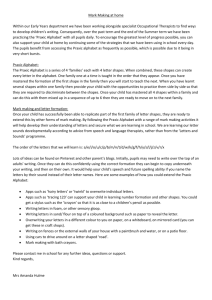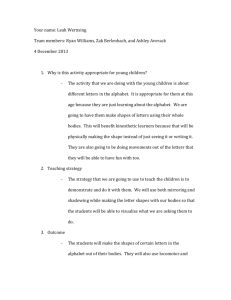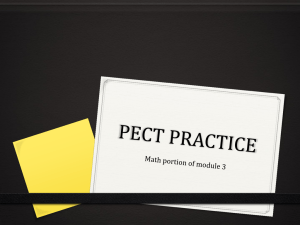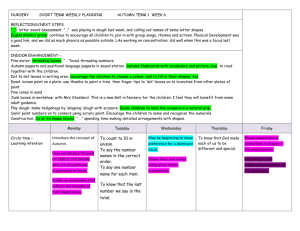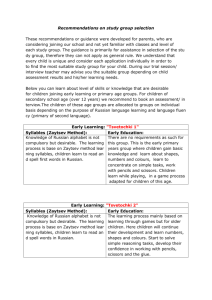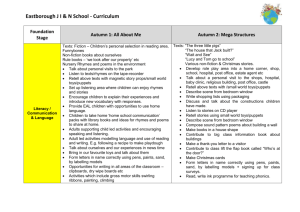Reading Readiness Competencies-007
advertisement
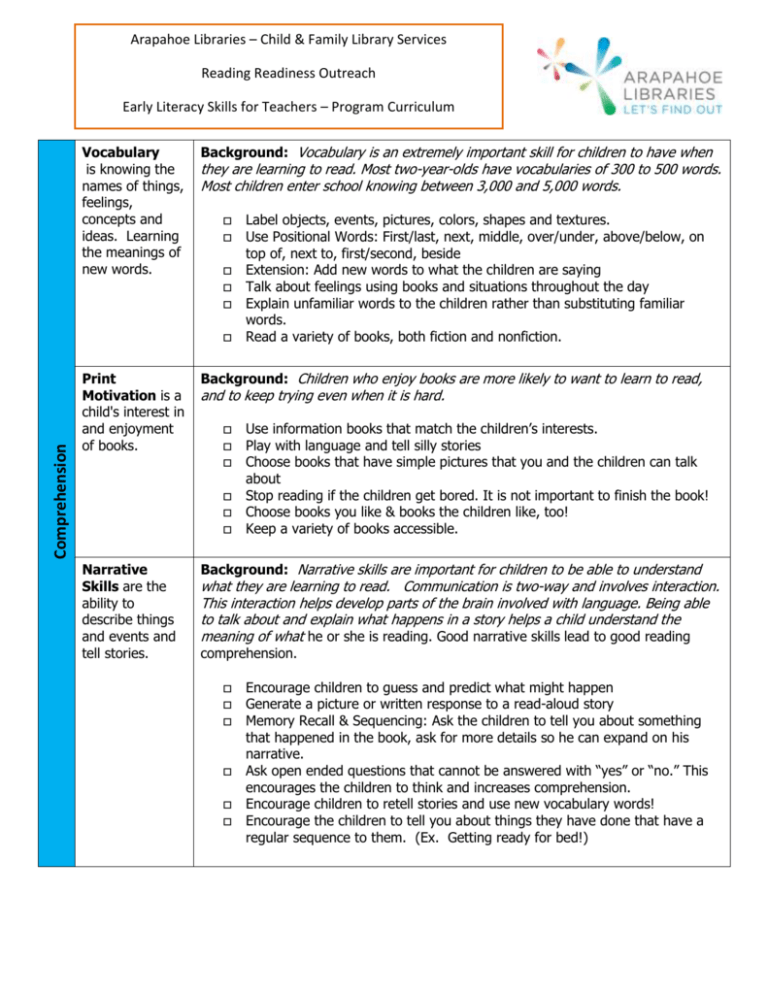
Arapahoe Libraries – Child & Family Library Services Reading Readiness Outreach Comprehension Early Literacy Skills for Teachers – Program Curriculum Vocabulary is knowing the names of things, feelings, concepts and ideas. Learning the meanings of new words. Background: Vocabulary is an extremely important skill for children to have when Print Motivation is a child's interest in and enjoyment of books. Background: Children who enjoy books are more likely to want to learn to read, Narrative Skills are the ability to describe things and events and tell stories. Background: Narrative skills are important for children to be able to understand they are learning to read. Most two-year-olds have vocabularies of 300 to 500 words. Most children enter school knowing between 3,000 and 5,000 words. □ Label objects, events, pictures, colors, shapes and textures. □ Use Positional Words: First/last, next, middle, over/under, above/below, on top of, next to, first/second, beside □ Extension: Add new words to what the children are saying □ Talk about feelings using books and situations throughout the day □ Explain unfamiliar words to the children rather than substituting familiar words. □ Read a variety of books, both fiction and nonfiction. and to keep trying even when it is hard. □ Use information books that match the children’s interests. □ Play with language and tell silly stories □ Choose books that have simple pictures that you and the children can talk about □ Stop reading if the children get bored. It is not important to finish the book! □ Choose books you like & books the children like, too! □ Keep a variety of books accessible. what they are learning to read. Communication is two-way and involves interaction. This interaction helps develop parts of the brain involved with language. Being able to talk about and explain what happens in a story helps a child understand the meaning of what he or she is reading. Good narrative skills lead to good reading comprehension. □ Encourage children to guess and predict what might happen □ Generate a picture or written response to a read-aloud story □ Memory Recall & Sequencing: Ask the children to tell you about something that happened in the book, ask for more details so he can expand on his narrative. □ Ask open ended questions that cannot be answered with “yes” or “no.” This encourages the children to think and increases comprehension. □ Encourage children to retell stories and use new vocabulary words! □ Encourage the children to tell you about things they have done that have a regular sequence to them. (Ex. Getting ready for bed!) Phonological Awareness is the ability to hear and play with the smaller sounds in words. Background: Being able to hear the beginning and ending sounds that make up words will help children sound out words when they begin to read. Children's phonological awareness begins to develop during the preschool years. Unless children are given help from teachers and parents, those with low levels of phonological awareness may continue to be delayed in this skill from the late preschool period forward. Most children who have difficulty in reading have trouble in phonological awareness. □ Recite songs, poems, nursery rhymes and stories with repeated rhymes □ Say words with a pause between the syllables (“rab” “it”) and have the children clap out words with you □ Point out and talk about words that rhyme □ After the children are familiar with a rhyming story or song, pause at the end of a sentence and let the children fill in the rhyming words □ Point out and talk about words that start or end with the same sound □ Make up silly words by changing the first sound in a word: milk, nilk, rilk, filk, silk, kilk Print Awareness is noticing print everywhere; and understanding that print has meaning Background: Before children learn to read, they must be familiar with how books work: books have a cover, in this country we begin to read at the top of the page from left to right, books have words and pictures to tell the story. When children feel comfortable with books, they can concentrate on reading. Children need to understand that print is meaningful in their daily lives and has many functions. Decoding □ Children see the pictures first, point out the words in the book and talk about them. □ Name Title page and point out the author and the illustrator. □ Read words everywhere you see them in the Environment: signs, logos and labels are all around us □ Hold book in upright position, turn pages sequentially, name left to right, top and bottom, front and back □ Children see the pictures first, point out □ Help children understand that there are words on the page that go with the pictures and that you are reading these words. This helps them to connect the words with the object on the page…words have meaning. Letter Knowledge is knowing that letters are different from each other, and have different names. Letters are symbols that have meaning. Background: To read written words, children must understand that they are made up of individual letters and that each letter has its own name and sound. Helping children learn about different shapes and understand how things are alike and different will help prepare them to learn the alphabet; learning to tell one letter from another involves being able to see the differences in letter shapes. □ Name each letter and talk about how they each have their own name made up of certain letters. Point out the Letters in the children’s names. □ Help children see different shapes. Point out shapes in a book and discuss how the shapes different. Talk about the shapes of things around the classroom. □ Read alphabet books and sing alphabet songs to introduce children to the names of letters, numbers, colors and familiar objects □ Point out and name letters in alphabet books, picture books, or on signs and labels. □ Compare Items that are: alike and different, explain as you match or sort items □ Help children to see the lines that make shapes and letters.

